Audis are an oddity. When Cadillac or Lincoln launches a nose-heavy car based on a front-wheel-drive platform, few auto writers take it seriously. The engine isn't mounted aft of the front axle, and it doesn't primarily (if not exclusively) drive the rear wheels? The car's weight distribution isn't balanced, or close to it? Then BMW and Mercedes-Benz have nothing to fear. well, Audi continues to mount its engines ahead of the axle, where they can drive only the front wheels (though now they often drive all four) and where they imbalance the car.
Yet Audis often win both magazine comparison tests and the real competition, that for sales. As I write this, the make has set 59 consecutive monthly sales records. How can this be? The recently updated 2016 Audi A6 midsize sedan provides some clues.
I tested both the A6 3.0T and the A7 3.0T (essentially an A6 hatchback) back in 2012, and the A7 3.0 TDI (diesel) in 2014, so this time I requested the four-cylinder 2.0T. (I actually requested the 2.0T back in 2012 as well, but one was not then available.) Can a turbocharged four-cylinder engine deliver the refined performance expected in an upscale sedan?
In the other corner, we have a car that checked off all of the car magazine boxes, yet which has not been selling well, the Cadillac CTS.
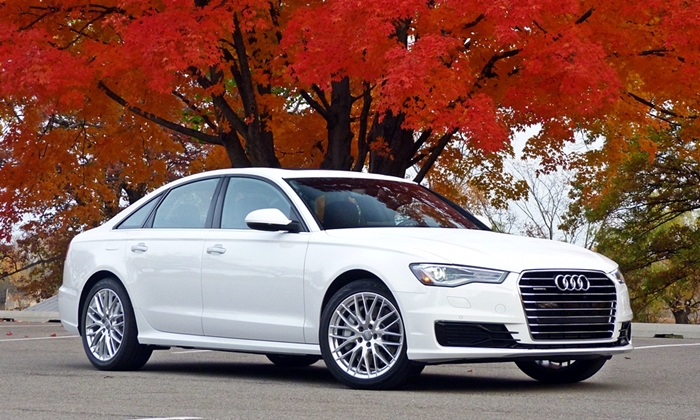
Compared to competitors, the A6 has a rounder shape and more massive nose. more A6 / S6 photos
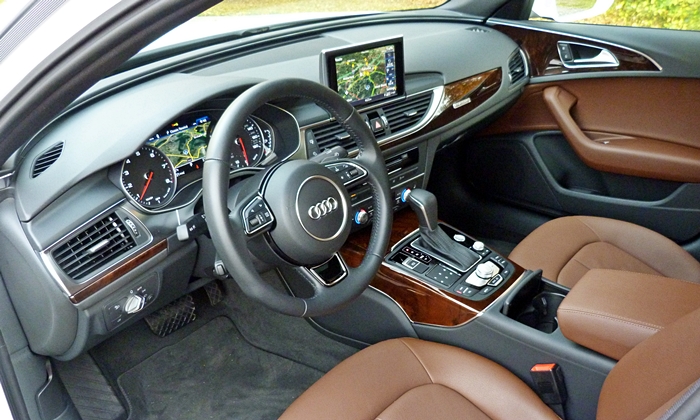
Tasteful styling continues inside the A6. Many other manufacturers copy this look.
| |
Compared to the CTS |
| Driving position & visibility |
 Better
Worse
Better
Worse
|
The view from the Audi A6's driver seat dramatically differs from that of its rear-wheel-drive competitors. The instrument panel and center console are lower and more compact, the pillars are thinner, and the windows are taller. The first benefit: better outward visibility, especially forward, but also to the sides and rear.
| Front seat room |
 Better
Worse
Better
Worse
|
The second benefit of the Audi A6's more open and expansive interior: it feels roomier, especially in the front seats. With no "race car" or "jet fighter" pretensions, the Audi is easier and more relaxing to drive. The BMW, Cadillac, and Mercedes interiors all feel tighter and more confining.
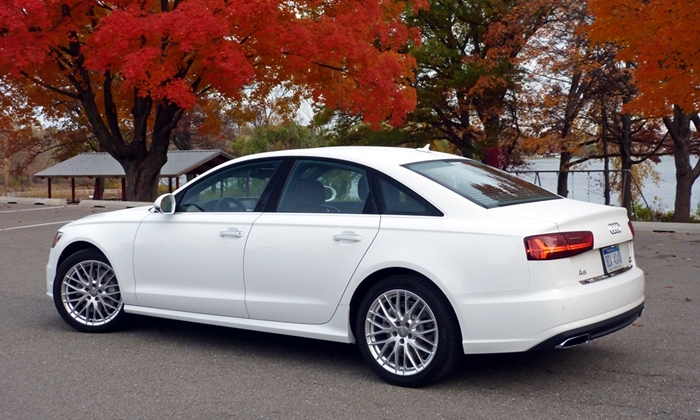
Extremely clean body sides. For more drama, spend another $8,000 for the related A7 hatchback.

This is what passes for above average usability in a current luxury sedan.
| Interior styling |
 Better
Worse
Better
Worse
|
Though others have been improving, in part through imitation, Audi remains the industry leader in interior design thanks to a tasteful minimalism. In comparison, Cadillacs and BMWs appear cluttered inside.
I haven't rated the relative handling of these cars, as they excel in very different ways.
If you're seeking the fancy-brand midsize sedan with the sportiest handling, then head to the nearest Cadillac dealership. But for typical around-town driving, the Audi A6 handles the best. Though I've driven the A6 and A7 in 3.0T form a few times, this was my first experience in the 2.0T. Well, with 100 fewer kilos in its nose, the A6 2.0T feels much more agile, responsive, and light-on-its-feet than I recall the 3.0T feeling, belying a 3,957-pound curb weight. While the A6 3.0T dutifully headed where it was pointed, it couldn't dance the way the 2.0T can. Less weight on the front tires might also contribute to more nuanced and natural-feeling steering feedback than I recall from past A6s, and than you'll receive in competitors.
Push the A6 2.0T hard, and it can feel a touch soft and rolly in ways that the more firmly sprung and more tightly damped CTS does not. Take a corner at speed, and the Cadillac leans and plows less. But how often does a largish sedan get driven hard? In typical driving, the A6 2.0T's driving position and handling combine to make it both relaxing and delightful, a difficult combination to pull off. When pushed hard, it lacks the athleticism of the CTS, but remains easily controllable. I was surprised by how much I enjoyed my week with it.
| Ride smoothness |
 Better
Worse
Better
Worse
|
The Audi A6's relatively compliant suspension absorbs bumps better than the Cadillac's (and the BMW's as well, if memory serves). You don't sense the weight of the wheels and tires as they rise and fall over uneven pavement. Noise levels also seemed lower than I recall in past Audis, if still not the lowest in the class.
| |
Compared to the CTS |
| Exterior styling |
 Better
Worse
Better
Worse
|
I'm less fond of the A6's exterior than of its interior. The long front overhang required by the forward-mounted engines and the weak rear haunches that are the flipside of the relatively thin rear pillars and tall windows don't lend the car the sportiest proportions or lines. The exterior of the related A7 hatchback is far more enticing. Unfortunately, the A7 isn't offered in 2.0T form and is about $8,000 more when comparing 3.0T to 3.0T.
This said, the A6 isn't an unattractive car, and as "why nots" go this is a weak one.
| Front seat support & comfort |
 Better
Worse
Better
Worse
|
Want a second reason that the Audi A6 might not be your best bet? Perhaps its front seats, as these despite a four-way lumbar adjustment (driver only unless you get the 3.0T Prestige) are just okay. Though likely what a German orthopedist recommended--I've sat in these seats for ten hours without any soreness--I'd personally prefer seats that are less firm and more form-fitting. This said, forms differ, and the Audi's might fit yours better than mine.
The rear seat is roomy but, like most, is mounted too close to the floor to provide adults with sufficient under-thigh support.
With that, I'm pretty much out of why-nots (though I'll touch on a potential one below). A very good all-around car, the Audi A6 has no glaring faults.
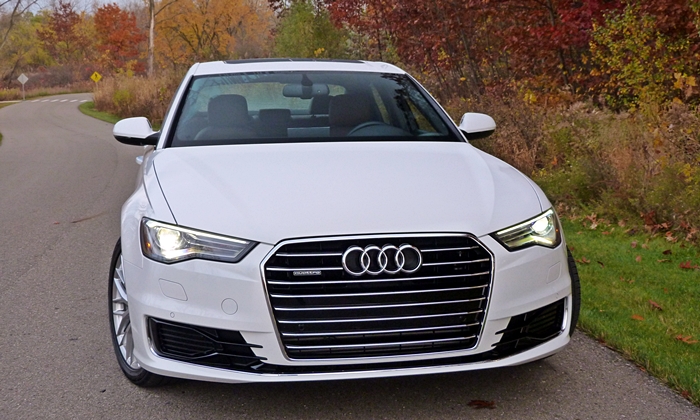
I didn't like the large uniframe grille a decade ago, but Audi's designers have made it work.

Plenty of room in the rear seat, but the cushion is a little low to the floor (a common issue).
| |
Compared to the CTS |
| Powertrain performance |
 Better
Worse
Better
Worse
|
With a boost from 220 to 252 horsepower for 2016, Audi's turbocharged 2.0-liter four-cylinder engine can accelerate the A6 to 60 mph in about seven seconds, a time that required a V8 not long ago. That said, the 333-horsepower A6 3.0T can do the same in under six.
The tested car was fitted with all-wheel drive, and thus the same ZF eight-speed automatic transmission as most Audis, BMWs, and Jaguars. With front-wheel drive, the A6 2.0T is now paired with a seven-speed dual-clutch automated manual transmission rather than the CVT of previous years. (Auto writers tend to despise CVTs because of their odd, non-linear feel.)
Beyond the objective full-throttle numbers, the 2.0T loses some points. Compared to the 3.0T's 333-horsepower V6, the 2.0T engine feels laggier, to be expected since it relies more on boost and employs a turbocharger rather than a supercharger. While the 3.0T responds instantaneously and effortlessly, the 2.0T's operation is less transparent, though still more refined and pleasing to the ear than the more pedestrian-sounding and -feeling 2.0T engine in the Cadillac. (The noises emanating from the Audi 2.0T tend to be lower in frequency.)
| Fuel economy |
 Better
Worse
Better
Worse
|
Among non-hybrid gasoline-powered upscale midsize sedans, the front-wheel-drive A6 2.0T has the highest EPA ratings: 24 mpg city, 35 mpg highway. (The BMW 528i scores one mpg lower in both tests.) Opt for "quattro" all-wheel drive, as in the tested car, and the ratings fall to 22/32. Still very good for the class but lower than the BMW 528i xDrive's 22/34.
Though improved for 2016, the Cadillac CTS still isn't in the running, scoring 21/31 with RWD and 21/29 with AWD.
Want the even better fuel economy of a diesel? Well, at the moment it'll have to be a BMW or Mercedes-Benz. Audi has benched the A6 TDI due to its well-publicized emissions issues.
Moving in the other direction, you don't sacrifice much fuel economy with Audi's even stronger engines. The A6 3.0T rates 20/30, while even the 450-horsepower V8-powered S6 manages 18/27--astoundingly good for such a large, ultra-powerful car.
In my real-world driving the A6 2.0T quattro's trip computer reported averages as high as 27 mpg in both suburban and highway driving. Make use of the engine's performance potential, and the reported average can fall as low as 18 mpg.
| Controls and instruments |
 Better
Worse
Better
Worse
|
All current premium brand midsize sedans have complicated controls. Relative to the touchscreen-based system in the Cadillac, the knob-and-button-operated MMI in the Audi is easier to use. After a few days I usually could perform the necessary operations without looking down at the console. But this isn't the same as being easy to use.
| Price or payments |
 Better
Worse
Better
Worse
|
Though the A6 2.0T's starting price of $47,125 isn't exactly low, it is the most affordable midsize Audi. Add $2,200 for all-wheel-drive and $3,700 for the Premium Plus Package standard on the 3.0T (navigation, proximity key, blind spot warning, obstacle detection, rearview camera, power steering column adjustments), and it's still $5,300 less than the latter. So how much is the supercharged V6's stronger, more immediate power delivery worth to you? For many buyers of these sedans, probably not $5,300 given that the 2.0T is already quick.
The tested car additionally included a $900 Warm Weather Package (4-zone climate control, sun shades) and $800 to upsize the wheels from 18s to 19s, for a total of $54,725.
When similarly equipped, the Audi A6 and Cadillac CTS tend to be very close in price, especially after adjusting for any remaining feature differences. A BMW 528i lists for a few thousand more than either. Not a big difference, but a significant one.
The value play in the segment comes from a volume brand, Hyundai. The second-generation Genesis lists for about $8,000 less than the Audi. But what do you give up? I'll be comparing the two cars in my next review.
| Reliability & durability |
 Better
Worse
Better
Worse
|
I wavered on whether to include reliability among the reasons not to buy an Audi A6, and ultimately did not because the issues here are largely potential ones. As it ages, the 2016 A6 could prove troublesome. The 2012s, after a good first few years, have been requiring more than the average number of repairs lately. But over the past year the 2013, 2014, 2015, and 2016 all have been good. Will this change as they near the end of the 4/50 factory warranty? Perhaps, but this remains to be seen. Or not.
In general, recent German cars tend to be good for the first four to six years--the latter the point at which CPO (certified pre-owed) warranties end. I often suggest that there are two smart ways to own a German car: under warranty, or if you're willing and able to perform most repairs yourself.
And the Cadillac CTS? We have a limited amount of data on the current car. What we do have suggests that it is more troublesome than the Audi.
The Audi A6 isn't the sportiest or best-looking premium-brand midsize sedan. But, given the sluggish sales of the best-handling car in the class, the Cadillac CTS, sporty handling doesn't seem to be a top priority for buyers. Given the priorities of these buyers, which reflect how and where these cars are typically driven, the Audi A6 could be the best of the bunch. Compared to the others, it has a more open interior and easier, more relaxed (yet still precise and disciplined) handling. I found it an unexpectedly enjoyable car to drive around town, where the advantages of a rear-wheel-drive platform are of very limited relevance.
And the 2.0T engine? While not as refined or as effortlessly strong as the 3.0T's V6, the four-cylinder still performs very well. For those seeking very good fuel economy (for the class) or simply a relatively low price, it's a fine choice. Plus, while the A6 2.0T might not be the ideal track car, when fitted with the lighter four-cylinder engine the largish sedan feels considerably more agile and responsive--and less nose-heavy--than it does with a V6. As a result, I actually enjoyed driving the A6 2.0T more than I did the A6 3.0T. You might as well.
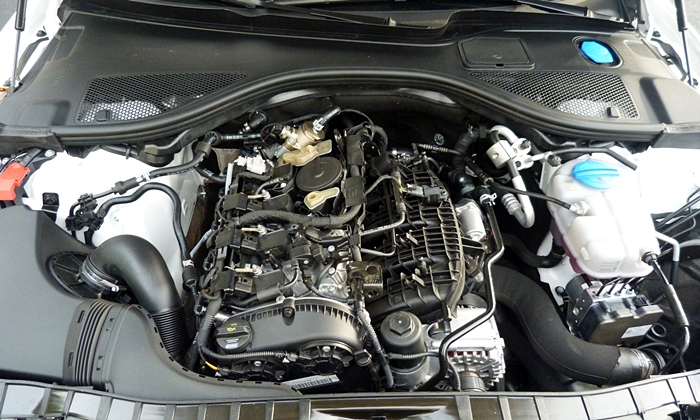
The 2.0-liter turbocharged engine gained 32 horsepower for 2016. Plenty strong, if a bit laggy.

It's a trunk. Sadly, the A6 wagon hasn't been offered here since 2011.
See more 2016 Audi A6 / S6 photos
Audi provided an insured car for a week with a tank of gas. Mitchel Reese of Cadillac of Novi (MI) helpfully provided a CTS for a comparison test drive. He can be reached at 248-476-4466.











